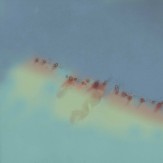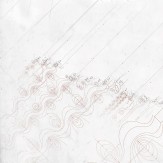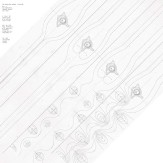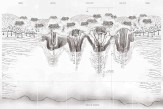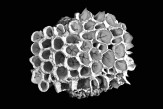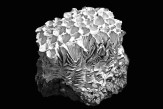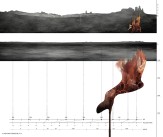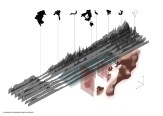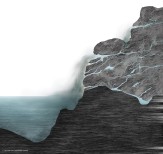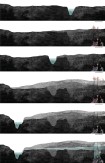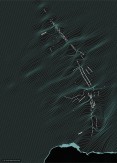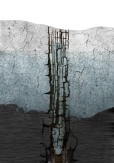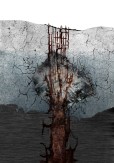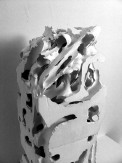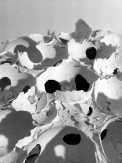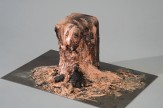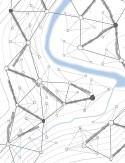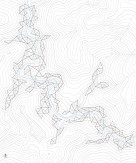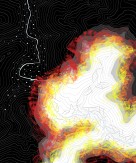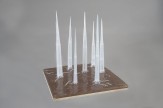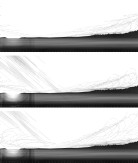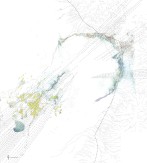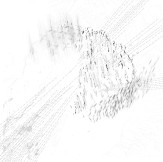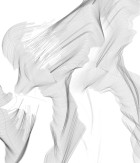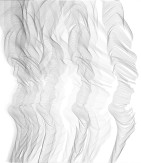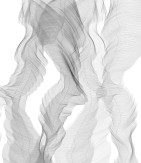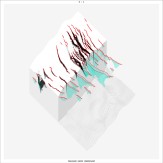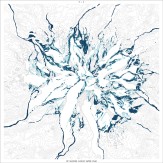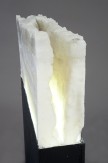Master of Architecture II Spring 2014
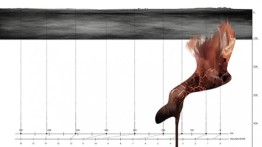
Projects
-

Conflicts between Coral Reef Formation and Natural Erosion
-
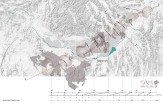
Water and Stone
-

Sequoia As Gestalt
-

Fluctuating Mass
-

Construction/Destruction
Back
Conflicts between Coral Reef Formation and Natural Erosion
Hancheng Chen
Atoll formation starts with a volcanic island which becomes extinct. As the island and ocean floor subside, coral growth builds a fringing reef, often including a shallow lagoon between the land and the main reef. As the subsidence continues, the fringing reef becomes a larger barrier reef further from the shore with a bigger and deeper lagoon inside. Ultimately, the island sinks below the sea, and the barrier reef becomes an atoll enclosing an open lagoon.
The Northwestern Hawaiian Islands comprise of small islands and atolls that are part of the Hawaiian–Emperor Seamount Chain. As they are constantly wrestling with different forces, such as the move of the tectonic plates and volcanic activity from 30 million years ago, the topography of the Northwestern Hawaiian Islands is constantly reconfigured.
Water and Stone
Yael Chen-Agmon
The interaction between the different states of materiality and their geological formations is explored through the relatively unstable geomorphology of the Snake River Basin, a complex system comprising an enormous aquifer and a volcanic process underground. The way water, and previously lava, penetrates through the labyrinth of the rock mass reveals the extremely complex structure of the landscape. A dynamic relationship between solids and liquids is exposed. The viscous lava melts the rock, gradually solidifies and transforms into a different type of rock. Though this volcanic rock blocks large amounts of water flows, it allows for the accumulation of a great body of water within its interstices. The water evaporates, condensates and splits into single molecules sometimes clinging to each other eroding its way through the rock. The processes of material formation and their interactions are at play in completely different scales.
Sequoia As Gestalt
Rosannah Sandoval
Condensation, Coalescence, and Capillarity are the delicate processes which are at the core of the survival of the largest living organism on earth, the Sequoia Semperviren. These forces occur in a cyclical process that can be seen in two different temporalities: daily as there are state changes of water through specific environmental conditions, and millenary as the accumulation of that phenomenon over thousands of years. It is the overlap of these two time spans that generates the ecosystem for these unlikely creatures to develop and perjure. The combination of systemic flows generates an incongruous organism that defies all resistance.
The Sequoia forest whole operates as a mega-organism, each tree like the limb within a larger structure. Fog, captured by the forest network provides the conditions for its specific growth and subsistence.
Fluctuating Mass
Adamantia Maria Fytou
Animated by mobility and growth, the Great Sand Dunes of Colorado are a land formation perpetually on the move. They do not refer to a fixed location or to a fixed shape; rather, matter flows from place to place and only momentarily comes together to embody a specific shape. Covering an area of 5x7 miles and reaching to 750 feet at its highest point, this massive dunefield functions by means of a recycling process of the sand—one that employs water as the regenerative power and wind as the reconfiguring. By means of two encircling creeks, sand is eroded from the upper parts of the dune field and deposited to lower ones—only to be transported back towards the top by the prevailing winds.
In response to the varying degrees of interaction between water and wind, three types of dunes are created within the entirety of the field. Each type moves at a different pace, evolving in various and fluctuating ways. This project represents an attempt to trace the relationships between these constituent parts, as they operate in different temporalities, ceaselessly redefining their edges and boundaries, and consequently of the whole.
Construction/Destruction
Meng Yang
A glacier, as a special water body, has a complicated system within which different forms of water intertwine and continuously transform. The immense power of a Glacier comes from both the tremendous movement of ice and the erosion on contiguous rock and earth systems by its intricate draining and cycles. In both senses, the “glacier” is defined as a much larger structure than its visual boundary.
This project focuses on the glacier of Mt. Rainier as the protagonist of a series of interaction and mutual shaping between its water structure and land form: between the rock ridge and the bulk of ice, between the ground surface and the drainage flow, between the volcanic gas and the melt water… all of which together aim to reveal the dynamic reality of the glacier system behind its solid and static appearance, and to envision potential hazards that could derive from it.


